EduQual Diploma: Strategic Management Report on Coca-Cola and PepsiCo
VerifiedAdded on 2022/11/13
|10
|2408
|454
Report
AI Summary
This report offers a comprehensive strategic management analysis of Coca-Cola and PepsiCo, evaluating their operations, organizational values, and external environmental factors. It begins by discussing the quality of systems and operations within both companies, emphasizing the importance of quality assurance and control in meeting customer expectations. The report then explores the role of organizational values, including mission, vision, and goals, in shaping strategic formulation. It delves into PESTEL and Five Forces analyses to assess the external environment and competitive landscape. Furthermore, the report examines stakeholder analysis, considering the impact of various stakeholders on the companies' strategies. The report concludes with a summary of key findings, highlighting areas for potential improvement and strategic recommendations for both Coca-Cola and PepsiCo. The analysis covers factors such as political stability, economic indicators, social trends, technological advancements, environmental considerations, and legal frameworks. The report also includes references to support the analysis and findings.

Running head: Strategic Management
Strategic Management
Name of the Student
Name of the University
Author Note
Strategic Management
Name of the Student
Name of the University
Author Note
Paraphrase This Document
Need a fresh take? Get an instant paraphrase of this document with our AI Paraphraser
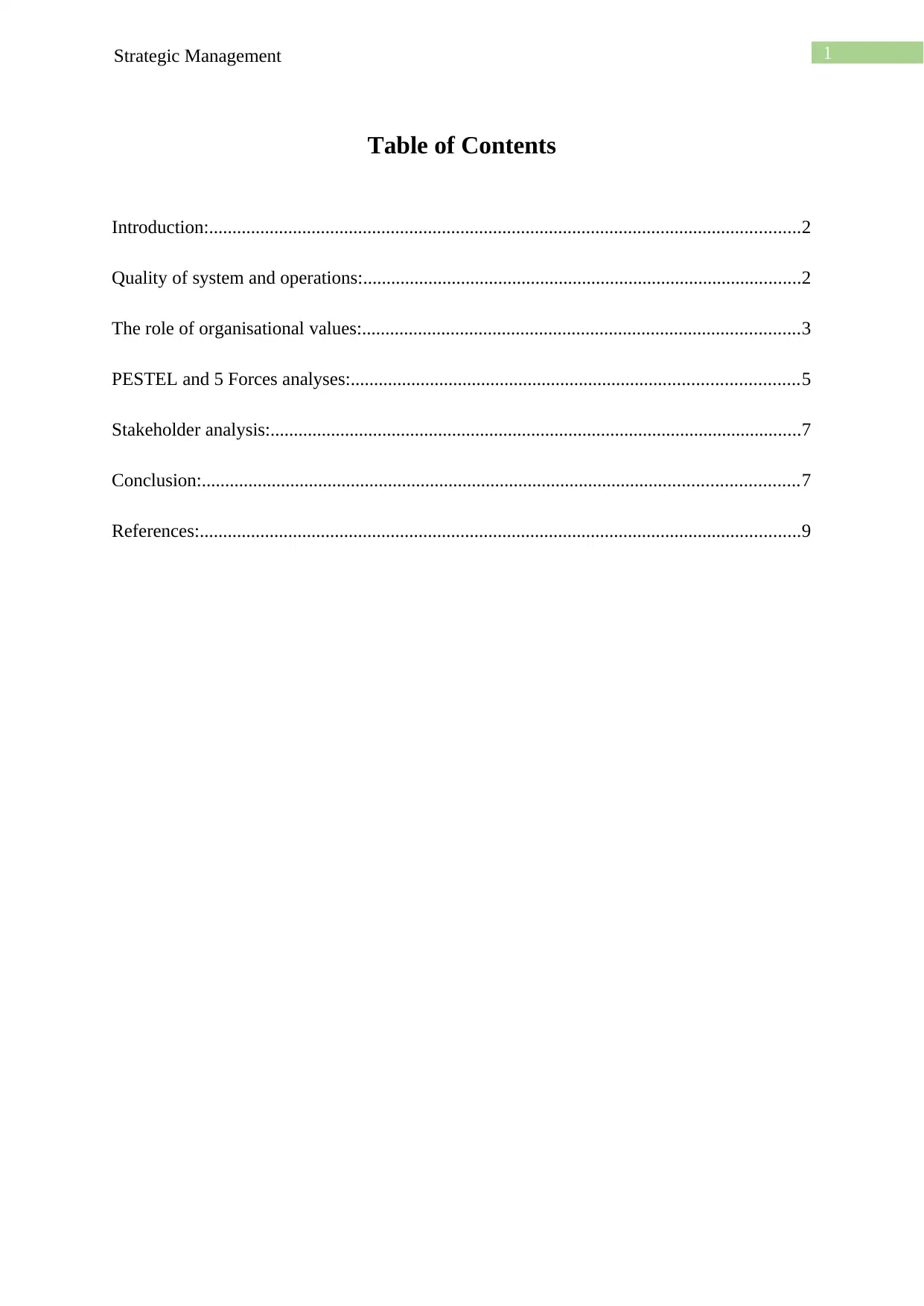
Strategic Management 1
Table of Contents
Introduction:...............................................................................................................................2
Quality of system and operations:..............................................................................................2
The role of organisational values:..............................................................................................3
PESTEL and 5 Forces analyses:................................................................................................5
Stakeholder analysis:..................................................................................................................7
Conclusion:................................................................................................................................7
References:.................................................................................................................................9
Table of Contents
Introduction:...............................................................................................................................2
Quality of system and operations:..............................................................................................2
The role of organisational values:..............................................................................................3
PESTEL and 5 Forces analyses:................................................................................................5
Stakeholder analysis:..................................................................................................................7
Conclusion:................................................................................................................................7
References:.................................................................................................................................9
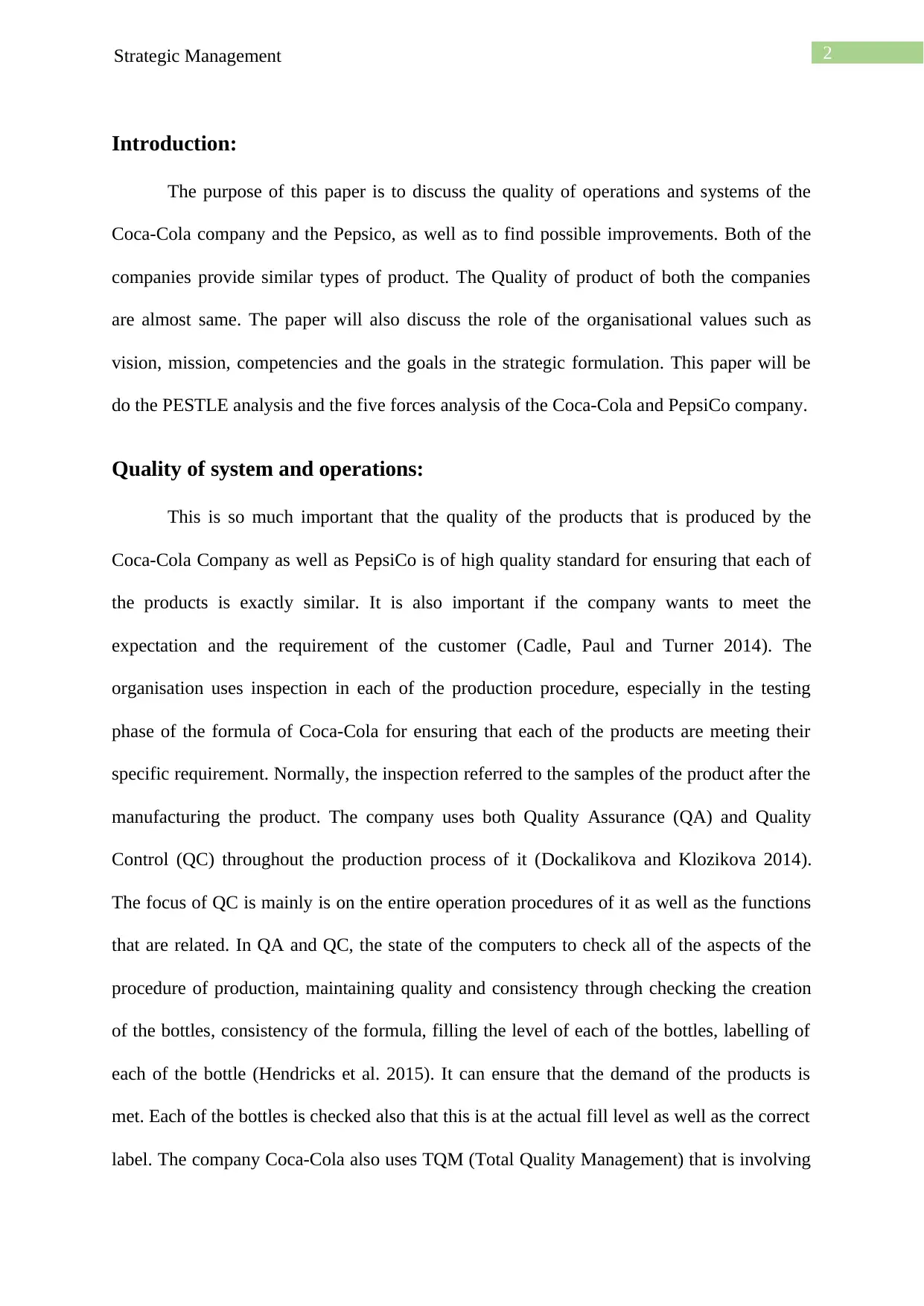
2Strategic Management
Introduction:
The purpose of this paper is to discuss the quality of operations and systems of the
Coca-Cola company and the Pepsico, as well as to find possible improvements. Both of the
companies provide similar types of product. The Quality of product of both the companies
are almost same. The paper will also discuss the role of the organisational values such as
vision, mission, competencies and the goals in the strategic formulation. This paper will be
do the PESTLE analysis and the five forces analysis of the Coca-Cola and PepsiCo company.
Quality of system and operations:
This is so much important that the quality of the products that is produced by the
Coca-Cola Company as well as PepsiCo is of high quality standard for ensuring that each of
the products is exactly similar. It is also important if the company wants to meet the
expectation and the requirement of the customer (Cadle, Paul and Turner 2014). The
organisation uses inspection in each of the production procedure, especially in the testing
phase of the formula of Coca-Cola for ensuring that each of the products are meeting their
specific requirement. Normally, the inspection referred to the samples of the product after the
manufacturing the product. The company uses both Quality Assurance (QA) and Quality
Control (QC) throughout the production process of it (Dockalikova and Klozikova 2014).
The focus of QC is mainly is on the entire operation procedures of it as well as the functions
that are related. In QA and QC, the state of the computers to check all of the aspects of the
procedure of production, maintaining quality and consistency through checking the creation
of the bottles, consistency of the formula, filling the level of each of the bottles, labelling of
each of the bottle (Hendricks et al. 2015). It can ensure that the demand of the products is
met. Each of the bottles is checked also that this is at the actual fill level as well as the correct
label. The company Coca-Cola also uses TQM (Total Quality Management) that is involving
Introduction:
The purpose of this paper is to discuss the quality of operations and systems of the
Coca-Cola company and the Pepsico, as well as to find possible improvements. Both of the
companies provide similar types of product. The Quality of product of both the companies
are almost same. The paper will also discuss the role of the organisational values such as
vision, mission, competencies and the goals in the strategic formulation. This paper will be
do the PESTLE analysis and the five forces analysis of the Coca-Cola and PepsiCo company.
Quality of system and operations:
This is so much important that the quality of the products that is produced by the
Coca-Cola Company as well as PepsiCo is of high quality standard for ensuring that each of
the products is exactly similar. It is also important if the company wants to meet the
expectation and the requirement of the customer (Cadle, Paul and Turner 2014). The
organisation uses inspection in each of the production procedure, especially in the testing
phase of the formula of Coca-Cola for ensuring that each of the products are meeting their
specific requirement. Normally, the inspection referred to the samples of the product after the
manufacturing the product. The company uses both Quality Assurance (QA) and Quality
Control (QC) throughout the production process of it (Dockalikova and Klozikova 2014).
The focus of QC is mainly is on the entire operation procedures of it as well as the functions
that are related. In QA and QC, the state of the computers to check all of the aspects of the
procedure of production, maintaining quality and consistency through checking the creation
of the bottles, consistency of the formula, filling the level of each of the bottles, labelling of
each of the bottle (Hendricks et al. 2015). It can ensure that the demand of the products is
met. Each of the bottles is checked also that this is at the actual fill level as well as the correct
label. The company Coca-Cola also uses TQM (Total Quality Management) that is involving
⊘ This is a preview!⊘
Do you want full access?
Subscribe today to unlock all pages.

Trusted by 1+ million students worldwide
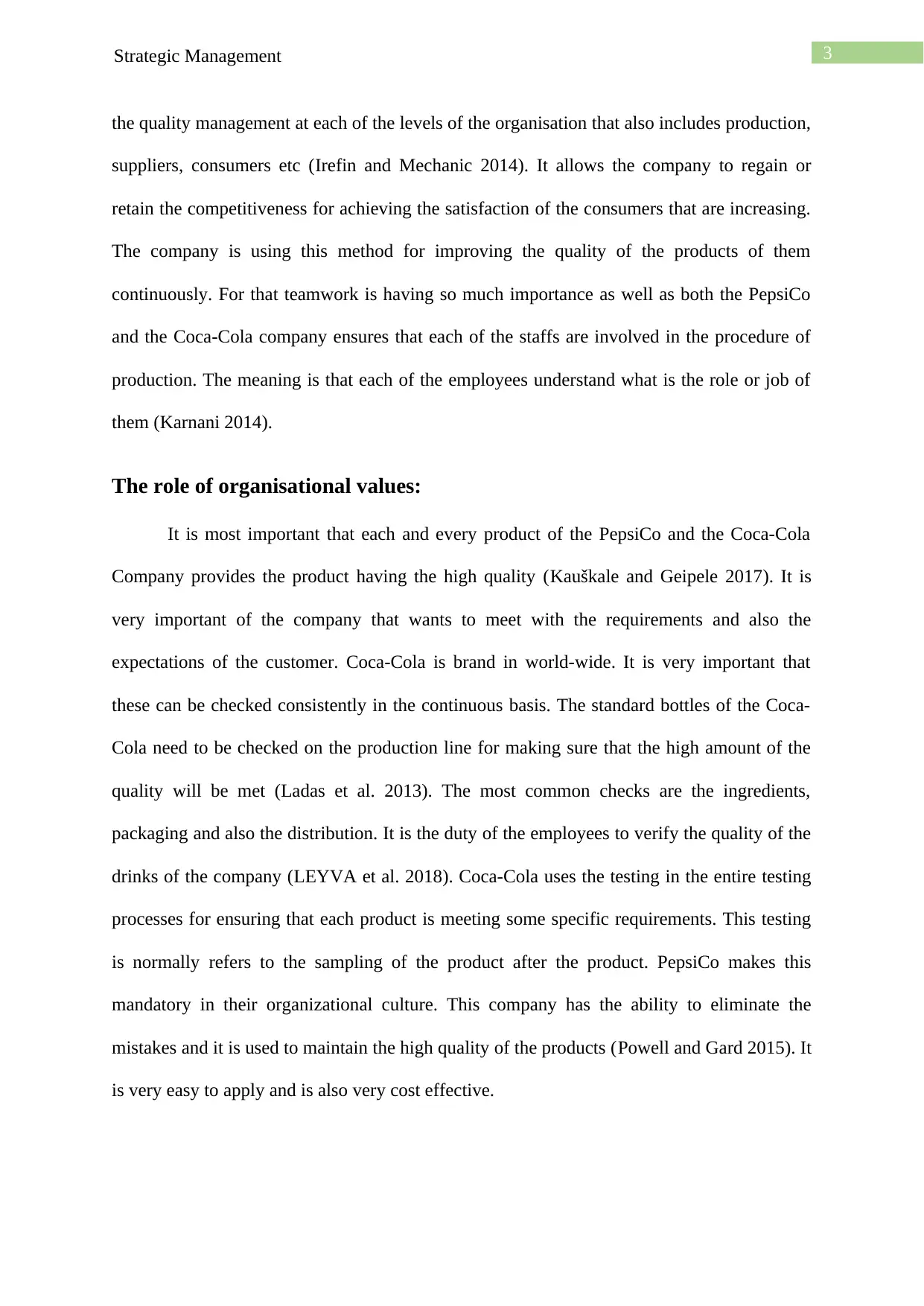
3Strategic Management
the quality management at each of the levels of the organisation that also includes production,
suppliers, consumers etc (Irefin and Mechanic 2014). It allows the company to regain or
retain the competitiveness for achieving the satisfaction of the consumers that are increasing.
The company is using this method for improving the quality of the products of them
continuously. For that teamwork is having so much importance as well as both the PepsiCo
and the Coca-Cola company ensures that each of the staffs are involved in the procedure of
production. The meaning is that each of the employees understand what is the role or job of
them (Karnani 2014).
The role of organisational values:
It is most important that each and every product of the PepsiCo and the Coca-Cola
Company provides the product having the high quality (Kauškale and Geipele 2017). It is
very important of the company that wants to meet with the requirements and also the
expectations of the customer. Coca-Cola is brand in world-wide. It is very important that
these can be checked consistently in the continuous basis. The standard bottles of the Coca-
Cola need to be checked on the production line for making sure that the high amount of the
quality will be met (Ladas et al. 2013). The most common checks are the ingredients,
packaging and also the distribution. It is the duty of the employees to verify the quality of the
drinks of the company (LEYVA et al. 2018). Coca-Cola uses the testing in the entire testing
processes for ensuring that each product is meeting some specific requirements. This testing
is normally refers to the sampling of the product after the product. PepsiCo makes this
mandatory in their organizational culture. This company has the ability to eliminate the
mistakes and it is used to maintain the high quality of the products (Powell and Gard 2015). It
is very easy to apply and is also very cost effective.
the quality management at each of the levels of the organisation that also includes production,
suppliers, consumers etc (Irefin and Mechanic 2014). It allows the company to regain or
retain the competitiveness for achieving the satisfaction of the consumers that are increasing.
The company is using this method for improving the quality of the products of them
continuously. For that teamwork is having so much importance as well as both the PepsiCo
and the Coca-Cola company ensures that each of the staffs are involved in the procedure of
production. The meaning is that each of the employees understand what is the role or job of
them (Karnani 2014).
The role of organisational values:
It is most important that each and every product of the PepsiCo and the Coca-Cola
Company provides the product having the high quality (Kauškale and Geipele 2017). It is
very important of the company that wants to meet with the requirements and also the
expectations of the customer. Coca-Cola is brand in world-wide. It is very important that
these can be checked consistently in the continuous basis. The standard bottles of the Coca-
Cola need to be checked on the production line for making sure that the high amount of the
quality will be met (Ladas et al. 2013). The most common checks are the ingredients,
packaging and also the distribution. It is the duty of the employees to verify the quality of the
drinks of the company (LEYVA et al. 2018). Coca-Cola uses the testing in the entire testing
processes for ensuring that each product is meeting some specific requirements. This testing
is normally refers to the sampling of the product after the product. PepsiCo makes this
mandatory in their organizational culture. This company has the ability to eliminate the
mistakes and it is used to maintain the high quality of the products (Powell and Gard 2015). It
is very easy to apply and is also very cost effective.
Paraphrase This Document
Need a fresh take? Get an instant paraphrase of this document with our AI Paraphraser
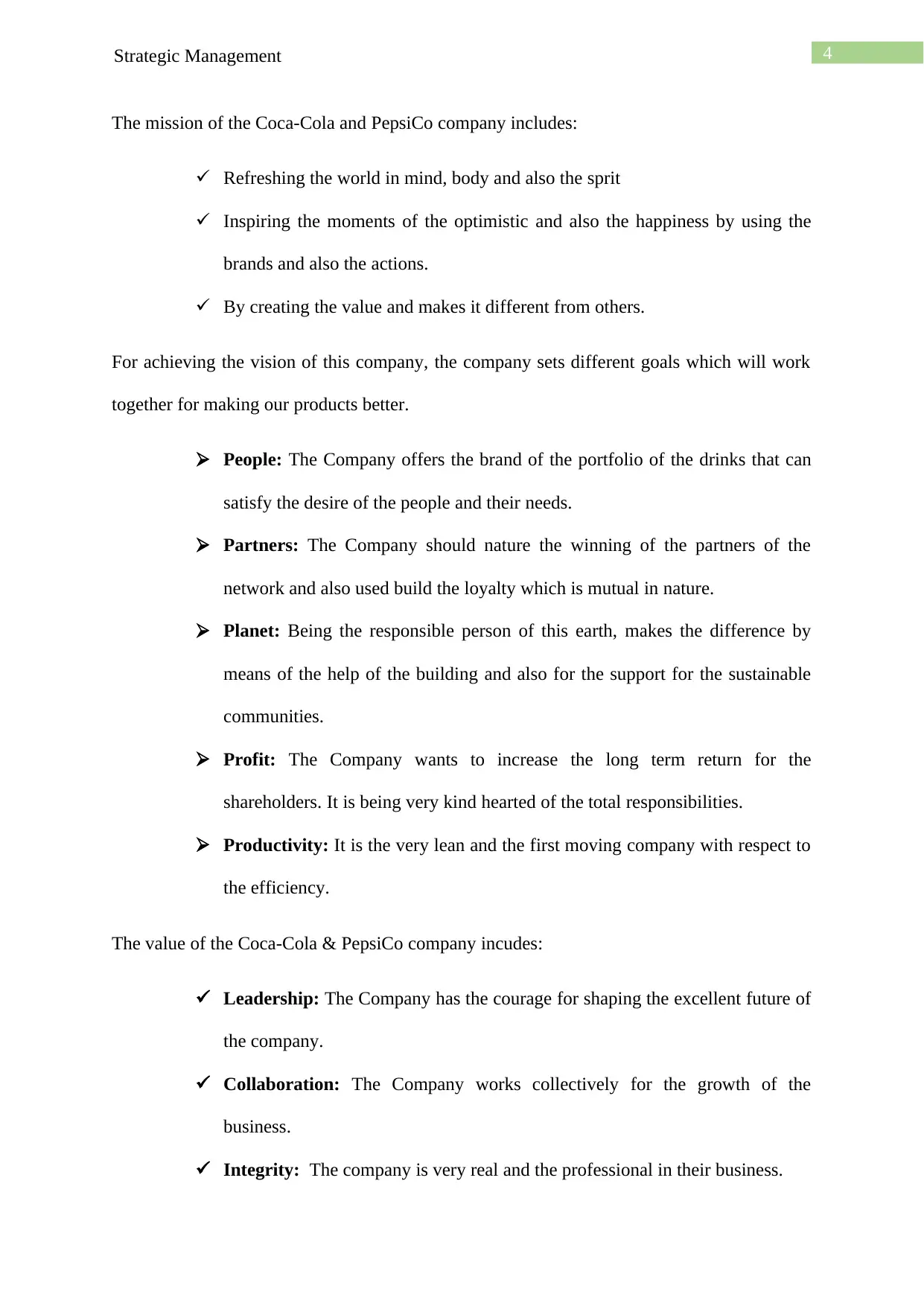
4Strategic Management
The mission of the Coca-Cola and PepsiCo company includes:
Refreshing the world in mind, body and also the sprit
Inspiring the moments of the optimistic and also the happiness by using the
brands and also the actions.
By creating the value and makes it different from others.
For achieving the vision of this company, the company sets different goals which will work
together for making our products better.
People: The Company offers the brand of the portfolio of the drinks that can
satisfy the desire of the people and their needs.
Partners: The Company should nature the winning of the partners of the
network and also used build the loyalty which is mutual in nature.
Planet: Being the responsible person of this earth, makes the difference by
means of the help of the building and also for the support for the sustainable
communities.
Profit: The Company wants to increase the long term return for the
shareholders. It is being very kind hearted of the total responsibilities.
Productivity: It is the very lean and the first moving company with respect to
the efficiency.
The value of the Coca-Cola & PepsiCo company incudes:
Leadership: The Company has the courage for shaping the excellent future of
the company.
Collaboration: The Company works collectively for the growth of the
business.
Integrity: The company is very real and the professional in their business.
The mission of the Coca-Cola and PepsiCo company includes:
Refreshing the world in mind, body and also the sprit
Inspiring the moments of the optimistic and also the happiness by using the
brands and also the actions.
By creating the value and makes it different from others.
For achieving the vision of this company, the company sets different goals which will work
together for making our products better.
People: The Company offers the brand of the portfolio of the drinks that can
satisfy the desire of the people and their needs.
Partners: The Company should nature the winning of the partners of the
network and also used build the loyalty which is mutual in nature.
Planet: Being the responsible person of this earth, makes the difference by
means of the help of the building and also for the support for the sustainable
communities.
Profit: The Company wants to increase the long term return for the
shareholders. It is being very kind hearted of the total responsibilities.
Productivity: It is the very lean and the first moving company with respect to
the efficiency.
The value of the Coca-Cola & PepsiCo company incudes:
Leadership: The Company has the courage for shaping the excellent future of
the company.
Collaboration: The Company works collectively for the growth of the
business.
Integrity: The company is very real and the professional in their business.
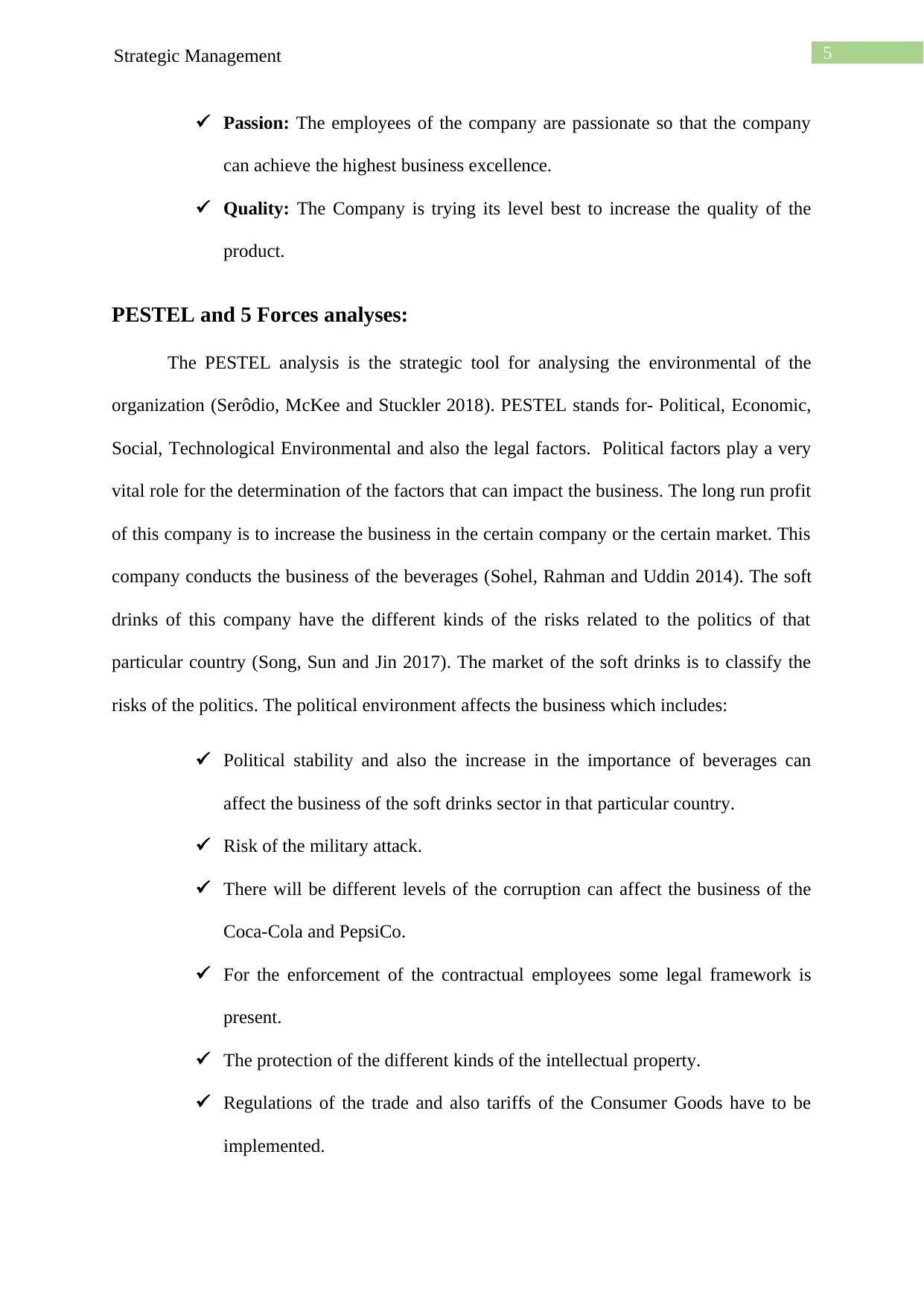
5Strategic Management
Passion: The employees of the company are passionate so that the company
can achieve the highest business excellence.
Quality: The Company is trying its level best to increase the quality of the
product.
PESTEL and 5 Forces analyses:
The PESTEL analysis is the strategic tool for analysing the environmental of the
organization (Serôdio, McKee and Stuckler 2018). PESTEL stands for- Political, Economic,
Social, Technological Environmental and also the legal factors. Political factors play a very
vital role for the determination of the factors that can impact the business. The long run profit
of this company is to increase the business in the certain company or the certain market. This
company conducts the business of the beverages (Sohel, Rahman and Uddin 2014). The soft
drinks of this company have the different kinds of the risks related to the politics of that
particular country (Song, Sun and Jin 2017). The market of the soft drinks is to classify the
risks of the politics. The political environment affects the business which includes:
Political stability and also the increase in the importance of beverages can
affect the business of the soft drinks sector in that particular country.
Risk of the military attack.
There will be different levels of the corruption can affect the business of the
Coca-Cola and PepsiCo.
For the enforcement of the contractual employees some legal framework is
present.
The protection of the different kinds of the intellectual property.
Regulations of the trade and also tariffs of the Consumer Goods have to be
implemented.
Passion: The employees of the company are passionate so that the company
can achieve the highest business excellence.
Quality: The Company is trying its level best to increase the quality of the
product.
PESTEL and 5 Forces analyses:
The PESTEL analysis is the strategic tool for analysing the environmental of the
organization (Serôdio, McKee and Stuckler 2018). PESTEL stands for- Political, Economic,
Social, Technological Environmental and also the legal factors. Political factors play a very
vital role for the determination of the factors that can impact the business. The long run profit
of this company is to increase the business in the certain company or the certain market. This
company conducts the business of the beverages (Sohel, Rahman and Uddin 2014). The soft
drinks of this company have the different kinds of the risks related to the politics of that
particular country (Song, Sun and Jin 2017). The market of the soft drinks is to classify the
risks of the politics. The political environment affects the business which includes:
Political stability and also the increase in the importance of beverages can
affect the business of the soft drinks sector in that particular country.
Risk of the military attack.
There will be different levels of the corruption can affect the business of the
Coca-Cola and PepsiCo.
For the enforcement of the contractual employees some legal framework is
present.
The protection of the different kinds of the intellectual property.
Regulations of the trade and also tariffs of the Consumer Goods have to be
implemented.
⊘ This is a preview!⊘
Do you want full access?
Subscribe today to unlock all pages.

Trusted by 1+ million students worldwide
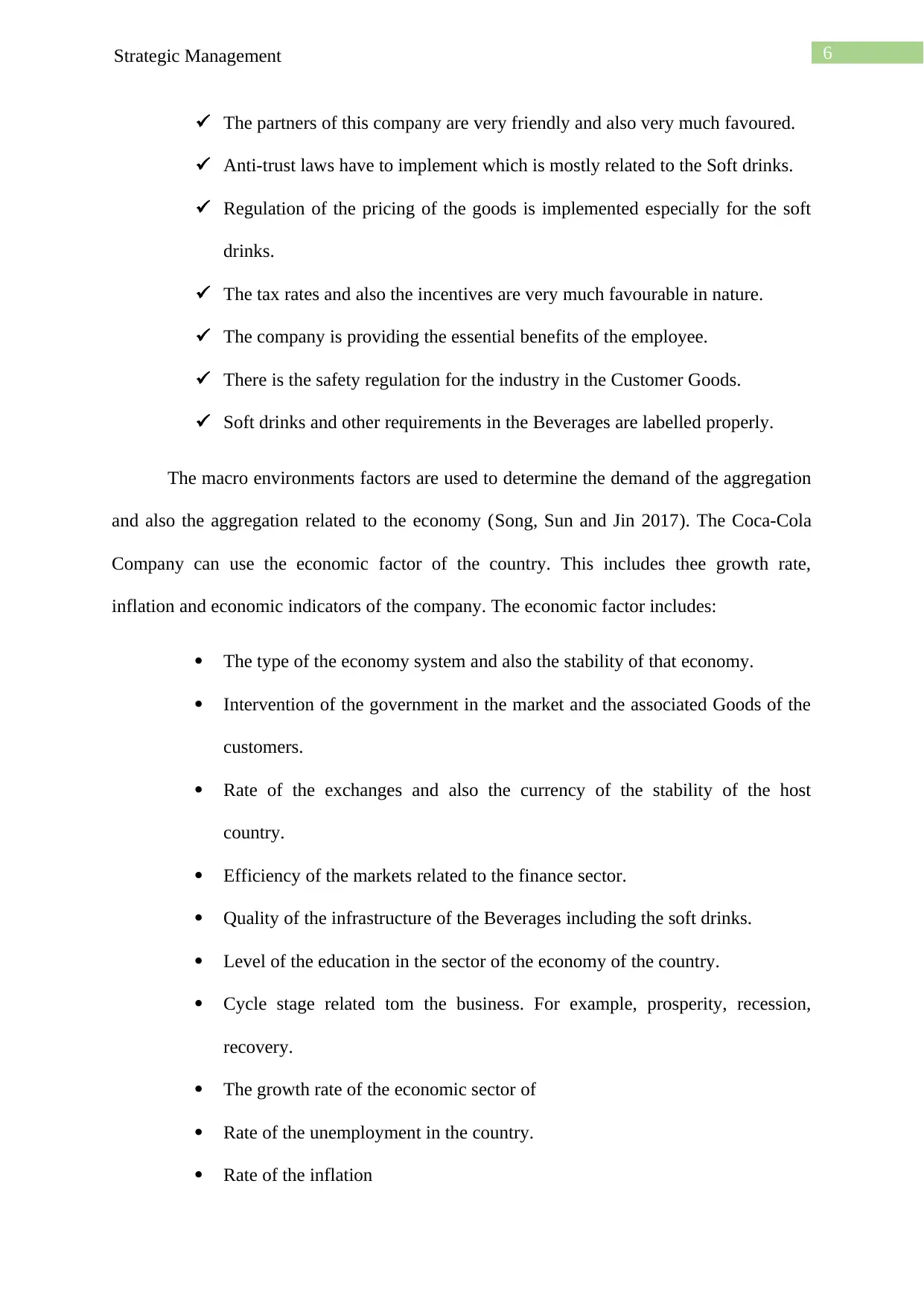
6Strategic Management
The partners of this company are very friendly and also very much favoured.
Anti-trust laws have to implement which is mostly related to the Soft drinks.
Regulation of the pricing of the goods is implemented especially for the soft
drinks.
The tax rates and also the incentives are very much favourable in nature.
The company is providing the essential benefits of the employee.
There is the safety regulation for the industry in the Customer Goods.
Soft drinks and other requirements in the Beverages are labelled properly.
The macro environments factors are used to determine the demand of the aggregation
and also the aggregation related to the economy (Song, Sun and Jin 2017). The Coca-Cola
Company can use the economic factor of the country. This includes thee growth rate,
inflation and economic indicators of the company. The economic factor includes:
The type of the economy system and also the stability of that economy.
Intervention of the government in the market and the associated Goods of the
customers.
Rate of the exchanges and also the currency of the stability of the host
country.
Efficiency of the markets related to the finance sector.
Quality of the infrastructure of the Beverages including the soft drinks.
Level of the education in the sector of the economy of the country.
Cycle stage related tom the business. For example, prosperity, recession,
recovery.
The growth rate of the economic sector of
Rate of the unemployment in the country.
Rate of the inflation
The partners of this company are very friendly and also very much favoured.
Anti-trust laws have to implement which is mostly related to the Soft drinks.
Regulation of the pricing of the goods is implemented especially for the soft
drinks.
The tax rates and also the incentives are very much favourable in nature.
The company is providing the essential benefits of the employee.
There is the safety regulation for the industry in the Customer Goods.
Soft drinks and other requirements in the Beverages are labelled properly.
The macro environments factors are used to determine the demand of the aggregation
and also the aggregation related to the economy (Song, Sun and Jin 2017). The Coca-Cola
Company can use the economic factor of the country. This includes thee growth rate,
inflation and economic indicators of the company. The economic factor includes:
The type of the economy system and also the stability of that economy.
Intervention of the government in the market and the associated Goods of the
customers.
Rate of the exchanges and also the currency of the stability of the host
country.
Efficiency of the markets related to the finance sector.
Quality of the infrastructure of the Beverages including the soft drinks.
Level of the education in the sector of the economy of the country.
Cycle stage related tom the business. For example, prosperity, recession,
recovery.
The growth rate of the economic sector of
Rate of the unemployment in the country.
Rate of the inflation
Paraphrase This Document
Need a fresh take? Get an instant paraphrase of this document with our AI Paraphraser
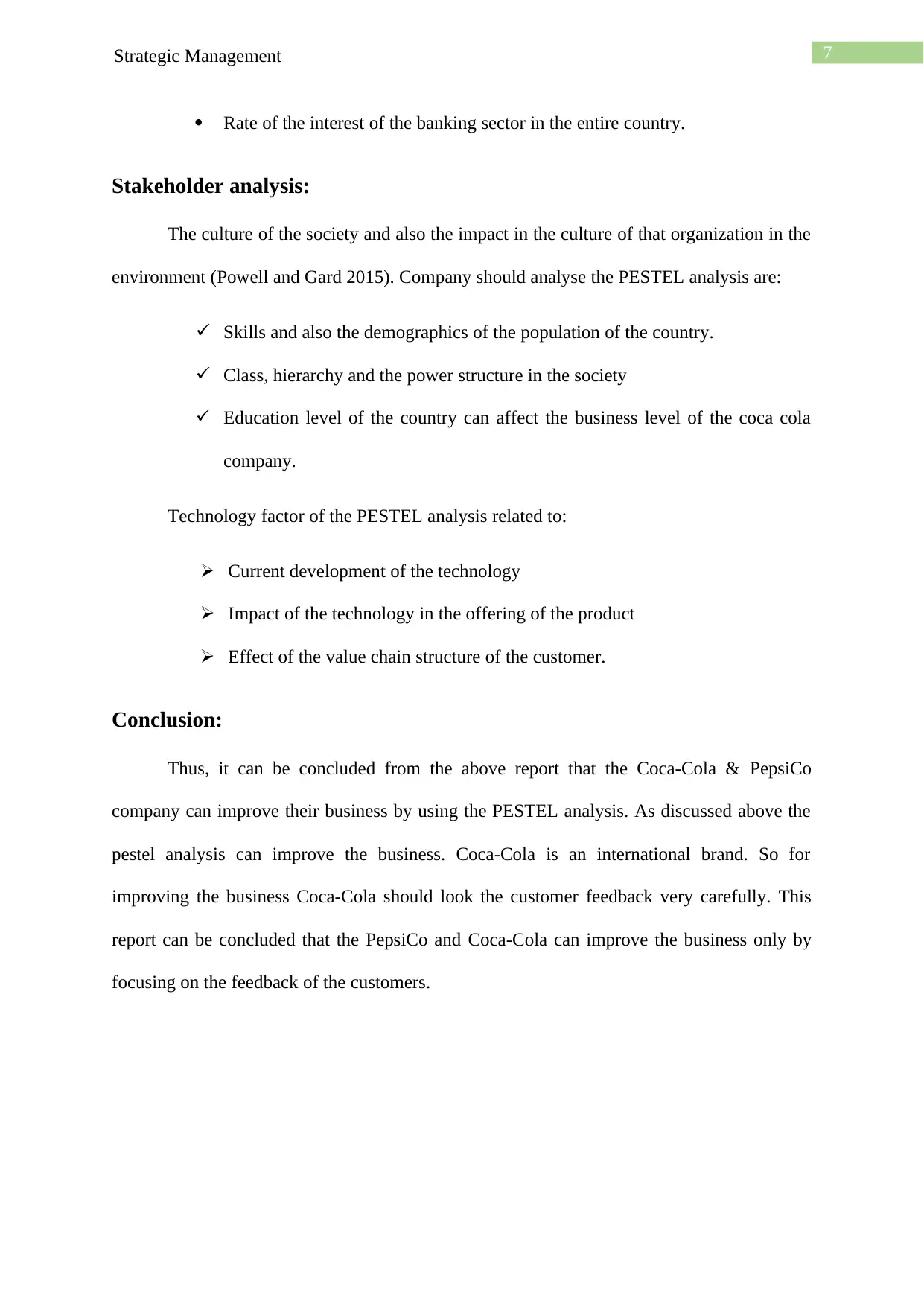
7Strategic Management
Rate of the interest of the banking sector in the entire country.
Stakeholder analysis:
The culture of the society and also the impact in the culture of that organization in the
environment (Powell and Gard 2015). Company should analyse the PESTEL analysis are:
Skills and also the demographics of the population of the country.
Class, hierarchy and the power structure in the society
Education level of the country can affect the business level of the coca cola
company.
Technology factor of the PESTEL analysis related to:
Current development of the technology
Impact of the technology in the offering of the product
Effect of the value chain structure of the customer.
Conclusion:
Thus, it can be concluded from the above report that the Coca-Cola & PepsiCo
company can improve their business by using the PESTEL analysis. As discussed above the
pestel analysis can improve the business. Coca-Cola is an international brand. So for
improving the business Coca-Cola should look the customer feedback very carefully. This
report can be concluded that the PepsiCo and Coca-Cola can improve the business only by
focusing on the feedback of the customers.
Rate of the interest of the banking sector in the entire country.
Stakeholder analysis:
The culture of the society and also the impact in the culture of that organization in the
environment (Powell and Gard 2015). Company should analyse the PESTEL analysis are:
Skills and also the demographics of the population of the country.
Class, hierarchy and the power structure in the society
Education level of the country can affect the business level of the coca cola
company.
Technology factor of the PESTEL analysis related to:
Current development of the technology
Impact of the technology in the offering of the product
Effect of the value chain structure of the customer.
Conclusion:
Thus, it can be concluded from the above report that the Coca-Cola & PepsiCo
company can improve their business by using the PESTEL analysis. As discussed above the
pestel analysis can improve the business. Coca-Cola is an international brand. So for
improving the business Coca-Cola should look the customer feedback very carefully. This
report can be concluded that the PepsiCo and Coca-Cola can improve the business only by
focusing on the feedback of the customers.
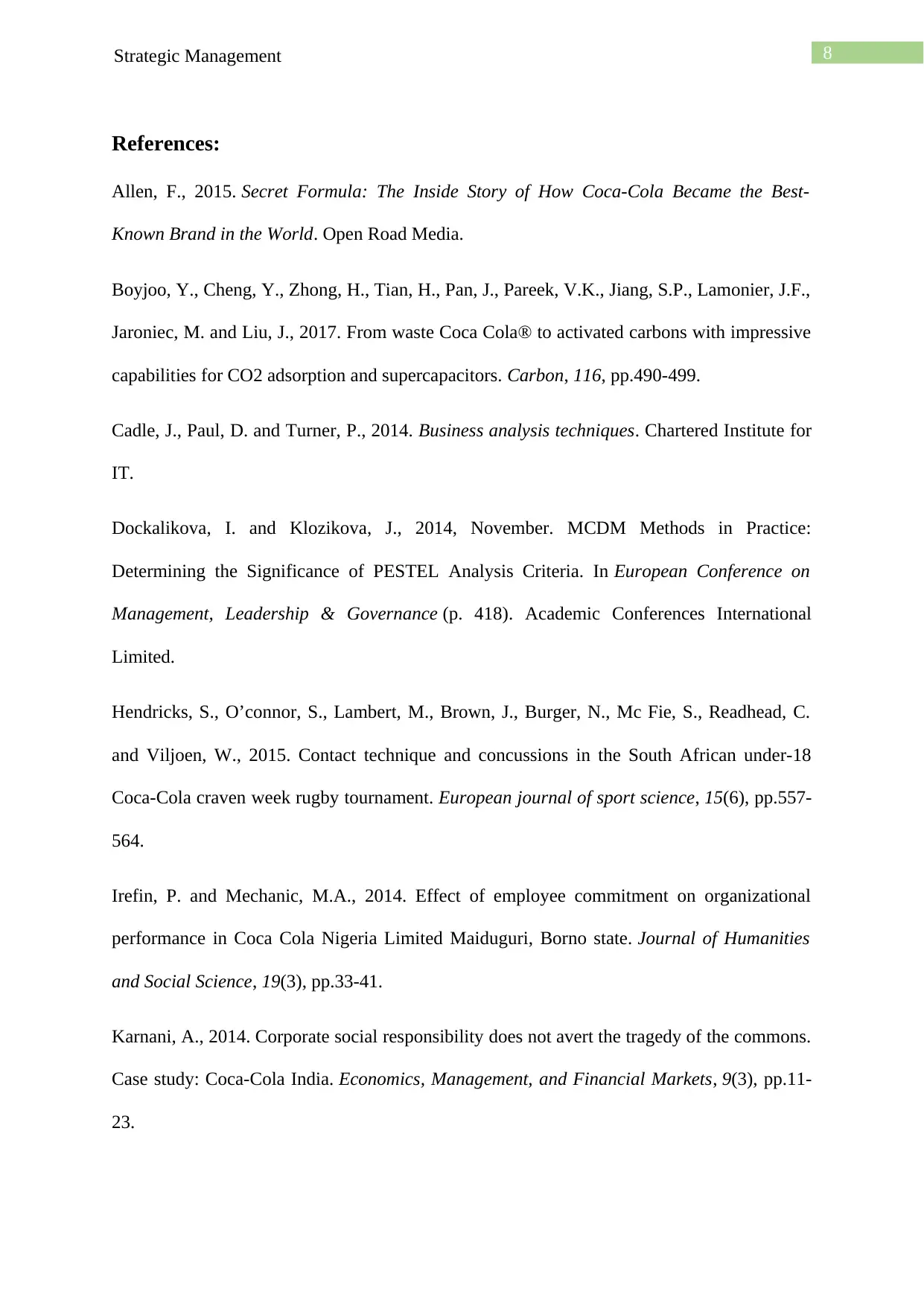
8Strategic Management
References:
Allen, F., 2015. Secret Formula: The Inside Story of How Coca-Cola Became the Best-
Known Brand in the World. Open Road Media.
Boyjoo, Y., Cheng, Y., Zhong, H., Tian, H., Pan, J., Pareek, V.K., Jiang, S.P., Lamonier, J.F.,
Jaroniec, M. and Liu, J., 2017. From waste Coca Cola® to activated carbons with impressive
capabilities for CO2 adsorption and supercapacitors. Carbon, 116, pp.490-499.
Cadle, J., Paul, D. and Turner, P., 2014. Business analysis techniques. Chartered Institute for
IT.
Dockalikova, I. and Klozikova, J., 2014, November. MCDM Methods in Practice:
Determining the Significance of PESTEL Analysis Criteria. In European Conference on
Management, Leadership & Governance (p. 418). Academic Conferences International
Limited.
Hendricks, S., O’connor, S., Lambert, M., Brown, J., Burger, N., Mc Fie, S., Readhead, C.
and Viljoen, W., 2015. Contact technique and concussions in the South African under-18
Coca-Cola craven week rugby tournament. European journal of sport science, 15(6), pp.557-
564.
Irefin, P. and Mechanic, M.A., 2014. Effect of employee commitment on organizational
performance in Coca Cola Nigeria Limited Maiduguri, Borno state. Journal of Humanities
and Social Science, 19(3), pp.33-41.
Karnani, A., 2014. Corporate social responsibility does not avert the tragedy of the commons.
Case study: Coca-Cola India. Economics, Management, and Financial Markets, 9(3), pp.11-
23.
References:
Allen, F., 2015. Secret Formula: The Inside Story of How Coca-Cola Became the Best-
Known Brand in the World. Open Road Media.
Boyjoo, Y., Cheng, Y., Zhong, H., Tian, H., Pan, J., Pareek, V.K., Jiang, S.P., Lamonier, J.F.,
Jaroniec, M. and Liu, J., 2017. From waste Coca Cola® to activated carbons with impressive
capabilities for CO2 adsorption and supercapacitors. Carbon, 116, pp.490-499.
Cadle, J., Paul, D. and Turner, P., 2014. Business analysis techniques. Chartered Institute for
IT.
Dockalikova, I. and Klozikova, J., 2014, November. MCDM Methods in Practice:
Determining the Significance of PESTEL Analysis Criteria. In European Conference on
Management, Leadership & Governance (p. 418). Academic Conferences International
Limited.
Hendricks, S., O’connor, S., Lambert, M., Brown, J., Burger, N., Mc Fie, S., Readhead, C.
and Viljoen, W., 2015. Contact technique and concussions in the South African under-18
Coca-Cola craven week rugby tournament. European journal of sport science, 15(6), pp.557-
564.
Irefin, P. and Mechanic, M.A., 2014. Effect of employee commitment on organizational
performance in Coca Cola Nigeria Limited Maiduguri, Borno state. Journal of Humanities
and Social Science, 19(3), pp.33-41.
Karnani, A., 2014. Corporate social responsibility does not avert the tragedy of the commons.
Case study: Coca-Cola India. Economics, Management, and Financial Markets, 9(3), pp.11-
23.
⊘ This is a preview!⊘
Do you want full access?
Subscribe today to unlock all pages.

Trusted by 1+ million students worldwide

9Strategic Management
Kauškale, L. and Geipele, I., 2017. Integrated approach of real estate market analysis in
sustainable development context for decision making. Procedia Engineering, 172, pp.505-
512.
Ladas, S.D., Kamberoglou, D., Karamanolis, G., Vlachogiannakos, J. and Zouboulis‐
Vafiadis, I., 2013. Systematic review: Coca‐Cola can effectively dissolve gastric
phytobezoars as a first‐line treatment. Alimentary pharmacology & therapeutics, 37(2),
LEYVA, M., HECHAVARRIA, J., BATISTA, N., ALARCON, J.A. and GOMEZ, O., 2018.
A framework for PEST analysis based on fuzzy decision maps. Revista ESPACIOS, 39(16).
Powell, D. and Gard, M., 2015. The governmentality of childhood obesity: Coca-Cola, public
health and primary schools. Discourse: Studies in the Cultural Politics of Education, 36(6),
pp.854-867.
pp.169-173.
Serôdio, P.M., McKee, M. and Stuckler, D., 2018. Coca-Cola–a model of transparency in
research partnerships? A network analysis of Coca-Cola’s research funding (2008–
2016). Public health nutrition, 21(9), pp.1594-1607.
Sohel, S.M., Rahman, A.M.A. and Uddin, M.A., 2014. COMPETITIVE PROFILE MATRIX
(CPM) AS A COMPETITORS’ANALYSIS TOOL: A THEORETICAL
PERSPECTIVE. International Journal of Human Potential Development, 3(1), pp.40-47.
Song, J., Sun, Y. and Jin, L., 2017. PESTEL analysis of the development of the waste-to-
energy incineration industry in China. Renewable and Sustainable Energy Reviews, 80,
pp.276-289.
\
Kauškale, L. and Geipele, I., 2017. Integrated approach of real estate market analysis in
sustainable development context for decision making. Procedia Engineering, 172, pp.505-
512.
Ladas, S.D., Kamberoglou, D., Karamanolis, G., Vlachogiannakos, J. and Zouboulis‐
Vafiadis, I., 2013. Systematic review: Coca‐Cola can effectively dissolve gastric
phytobezoars as a first‐line treatment. Alimentary pharmacology & therapeutics, 37(2),
LEYVA, M., HECHAVARRIA, J., BATISTA, N., ALARCON, J.A. and GOMEZ, O., 2018.
A framework for PEST analysis based on fuzzy decision maps. Revista ESPACIOS, 39(16).
Powell, D. and Gard, M., 2015. The governmentality of childhood obesity: Coca-Cola, public
health and primary schools. Discourse: Studies in the Cultural Politics of Education, 36(6),
pp.854-867.
pp.169-173.
Serôdio, P.M., McKee, M. and Stuckler, D., 2018. Coca-Cola–a model of transparency in
research partnerships? A network analysis of Coca-Cola’s research funding (2008–
2016). Public health nutrition, 21(9), pp.1594-1607.
Sohel, S.M., Rahman, A.M.A. and Uddin, M.A., 2014. COMPETITIVE PROFILE MATRIX
(CPM) AS A COMPETITORS’ANALYSIS TOOL: A THEORETICAL
PERSPECTIVE. International Journal of Human Potential Development, 3(1), pp.40-47.
Song, J., Sun, Y. and Jin, L., 2017. PESTEL analysis of the development of the waste-to-
energy incineration industry in China. Renewable and Sustainable Energy Reviews, 80,
pp.276-289.
\
1 out of 10
Related Documents
Your All-in-One AI-Powered Toolkit for Academic Success.
+13062052269
info@desklib.com
Available 24*7 on WhatsApp / Email
![[object Object]](/_next/static/media/star-bottom.7253800d.svg)
Unlock your academic potential
Copyright © 2020–2025 A2Z Services. All Rights Reserved. Developed and managed by ZUCOL.





